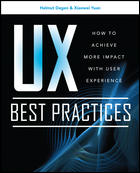Book: UX Best Practices

UX Best Practices – How to Achieve More Impact with User Experience
Helmut Degen & Xiaowei Yuan (Eds.)
McGraw-Hill Osborne Media, 2011
ISBN-10: 007175251X, ISBN-13: 978-0071752510
304 pages
(Amazon)
Helmut Degen, Ph.D., works as a program manager for Siemens Corporate Research (SCR). He was previously a user experience design lead and senior user experience manager for Vodafone Global Marketing in Dusseldorf, Germany, and for the Siemens User Interface Design center in Munich, Germany.
Xiaowei Yuan, Ph.D., is an expert commissioner of the Standardization Administration of the People’s Republic of China, and the founder of ISAR User Interface Design. He was previously head of the Siemens User Interface Design Center, Beijing, China.
Gerd Waloszek of SAP User Experience wrote a lengthy review on the book. Here are his concluding paragraphs:
“As I have already mentioned, the editors’ vision of the book is that “readers change perspective from a ‘how-to’ perspective to an ‘impact’ perspective”, that they “then apply the new perspective to their organization or customers’ organization systematically to achieve greater impact with UX contributions more often.” However, in recognition of the survey results from October 2011, they are more modest in their goals for the book when they state,”The UX practices described in the success stories in this book can be used as a starting point to improve existing UX processes,” because “the UX success stories in this book are rather exceptional in the UX industry and can be considered as benchmarks.” Of course, this is by no means a contradiction and both aspects are useful. But when the editors finally promote the “model” perspective for the book, it has eventually become what they initially intended not to publish: a “how-to” book.
Nonetheless, considering its broad perspective with respect to industries (in-depth case studies from Yahoo!, Siemens, SAP, Haier, Intuit, Tencent, and more), its cross-regional coverage (USA, Europe, China), and its variety of user experience techniques (for example, analyzing user needs and expectations, creating design concepts, prototyping, using agile development, conducting usability testing, developing user interface guidelines, defining user interface patterns, and specifying metrics), the book is definitely a rich and unique resource for readers who want to learn about the state of the UX industry, find the gaps between what would be desirable and what is still the current state of affairs in the industry, and, last but not least, get familiar with approaches that help provide UX teams with more impact on products and organizations.”



